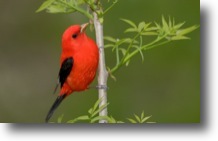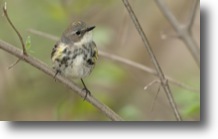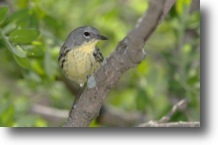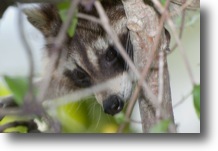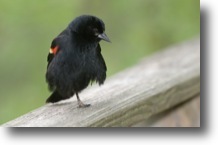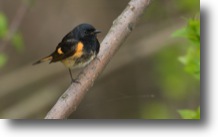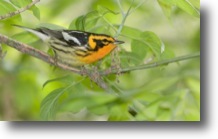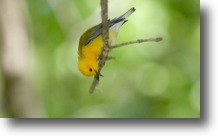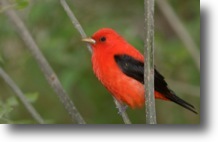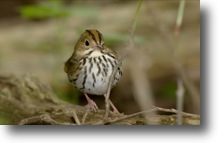Magee Marsh 2013
May 11-14
Photos and Blog by Bill Majoros
One of my best photos on this yearís trip: a blackburnian warbler.
On past trips I never seemed to be able to get close shots of these birds.
On this trip they seemed to be everywhere, and I got tons of photos of them.
Every year is different. Thatís why I come here every single year.
Click here to view these
| Magee
Marsh, in northwestern Ohio, is one of those
birding destinations that I just never get tired
of. I go every single year (when possible),
and because every year is different, I never get
the feeling that Iíve been here too many
times. Although itís known as the Warbler
Capital of the World, you can see many other
bird species besides warblers here. Even in
a bad year (like last
year, which was the worst Iíve seen), you
can still get some lifelong keepers, if you put in
the effort. And I do put in a lot of effort
on my Magee trips. I typically spend around
12 hours in the field each day hauling around my
big, heavy camera gear. Itís
exhausting. My vacation time at Magee is,
quite literally, harder than my day job. But
itís always worthwhile. This year I knew that this might be my last trip to Magee for a while, since Iím starting graduate school this fall and probably wonít have the ability to travel here every single year. I was therefore delighted to find that this ended up being one of my very best years at Magee so far. I was here for only four days this year, but the first two of those days were two of the very best days I have ever seen at Magee, with nonstop birding literally all day long. The next two days slacked off a bit, but as youíll see from reading my field notes below, the fourth and final day offered a very fitting endingóa surprise visit by a rare bird.  This scarlet Tanager showed up at the end of my first day. I barely had enough energy left to photograph it, but it was more than worthwhile. It was an amazing end to an amazing day. Some equipment notes, for photographers: As on recent Magee trips, I primarily relied on a 400mm lensómine is a hand-holdable f/4, which lets in lots of light, but f/5.6 is fine in many cases, and most importantly I use an extension tube to reduce the close focus distance to about 3.5 feet, so I can still focus when the bird is right at the edge of the boardwalk. I used an external flash unit with a fresnel lens to focus the light and conserve battery power (mostly I shot with flash at 1/64 power, in manual mode), and I use an external battery pack with 8 AA batteries that I charge every night with ďThe SquidmonsterĒ (read about it here). I wore my signature knee pads (people always seem to recognize me by my knee pads...?!), which allowed me to comfortably shoot ground-level birds (like ovenbirds) at eye level. I shoot exclusively in manual mode: both manual on the camera and manual in the flash. My camera settings were: 1/300 sec, ISO 200 to 500 in most cases (with some extreme exceptions going down to 100 or up to 1600), aperture one stop below wide open (so, f/5.6 for my lens), or in some cases wide open (f/4). For more information on camera settings and equipment, and specifically information on shooting warblers, please read my FREE online instructional book: Secrets of Digital Bird Photography. On this trip I took a total of 5,956 photos during my 42 hours in the field. BLOG
Friday May 10 Early in the morning I loaded my two girls, Brandy and Daisy, into the car along with all my photo gear, and eagerly hit the road. The trip up from North Carolina is usually relatively painless, with most of the trip following major highways. My favorite part is the trip through West Virginia, where the mountains rear up on both sides to provide some very pleasant scenery.  Driving to Ohio from North Carolina. I always enjoy the passage through West Virginia. The WV mountains are beautiful. Itís the best part of the 11-hour drive. The full drive takes about 11 hours. This year the drive was very tolerable until I reached Ohio. Right around the time I reached the border of Ohio it started to rain. After that I drove through several severe thunderstorms, and then I recalled that last year the same thing had happened, right around Columbus. This year was a little more stressful, because after ten hours of solid driving I became impatient and moved into the fast lane between Cleveland and Toledo, where I suddenly started to hydroplane while closely sandwiched between a concrete wall and a big 18-wheeler going 70 mph. I was happy when we arrived safely at the Red Roof Inn. I called in some takeout at the Chinese place next door as I do every year. This year I ordered a double serving of extra rice for my girls, who quickly sacked out after dinner.  Brandy and Daisy stretching their limbs after 11 hours stuck in the car. This was Daisyís first long car ride, and Brandyís second. Saturday May 11 - MIGRATORY BIRD DAY (12 hours, 1797 photos) International Migratory Bird Day (IMBD) is a big deal at Magee. It always draws the biggest crowds ó literally thousands of people, both young and old, flock to this place on this one day to experience the peak of the warbler migration. For me itís always the most exciting day, though as a photographer I always find it to be one of the most trying days, because of the crowds. Getting great photos of warblers on the boardwalk requires skill in ďworkingĒ the bird, and with massive crowds in the way there simply is no way to effectively ďworkĒ the bird. ďWorkingĒ the bird means moving rapidly up and down a short stretch of boardwalk around where a bird is foraging, trying many different angles as the bird moves about, in hopes of getting a fortuitous image in which the bird happens to be in a good pose at the same time that the background happens to be clean and reasonably nicely lit. So on IMBD I just have to take what photos I can get when the crowds occasionally thin, such as around lunchtime or dinner time, or at random times when a bird pops up in a place where there just donít happen to be many people right then. This morning I arrived at about 8am. Since I knew the crowds would be insane I first let my dogs swim at the dog-training beach; theyíd spent 11 solid hours in the car yesterday and deserved some fun time of their own. Because it was IMBD the parking lot was already packed, though I was able to get a spot at the back where my friends always park, and I recognized their cars. Also, I was delighted to see that someone had kept the tradition of the Orange Tree started last year!  The Orange Tree - 2013. Last year someone set up an artificial ďorange treeĒ to attract the orioles in a nice location with clean backgrounds for close-up photography on days of low warbler activity. I was delighted upon arriving this year to see that the ďtreeĒ was still being maintained in the same location. Last year had been pretty terrible for warbler photography, so someone had set up the ďorange treeĒ and whenever the birding was slow on the boardwalk photographers arranged their lawn chairs around the orange tree and shot orioles. My oriole photos from last year are the best Iíve ever gotten. Abandoning the orange tree for now, I got out the big 600mm lens and headed toward the marsh with my pups. Dogs are not allowed on the boardwalk, but thereís plenty of habitat at the edge of the marsh where pets are allowed, and sometimes the birding there is good (depending on the wind and other conditions).  Brandy, Daisy, and me shooting in the lawn at the edge of the woods. The large box above my lens is a fresnel flash extender, which you can read about in my online book. I soon ran into one of my many Magee friends, Dale, who informed me that the birding was better on the boardwalk than along the edge of the forest, so I decided to put away the big 600mm rig and switch to a much more portable 400mm hand-held rig (with an extension tube for close focusing). According to Dale, the west end of the boardwalk was so jam-packed with people it wasnít even worth trying, but the east end was quite tolerable. I took his advice and found that the east end was indeed very tolerable. Many of the birds were up fairly high in the trees, but by the time I got to the mid-section of the boardwalk I started to find some subjects lower down. One of my most exciting finds was an ovenbird foraging on the ground just a few feet from the boardwalk:  Ovenbird hunting three feet from the boardwalk. In order to get this eye-level view I had to lie on my belly on the boardwalk and stick my lens under the lower railing. It was quite uncomfortable, but it always pays to be flexible in the field! 1/300sec 400mm f/5.6 + extension tube, ISO250 This was indeed a very fortunate find, because I would find this same bird foraging along this stretch of the boardwalk again and again over the next several days, and each time I was able to get shots of the bird at different angles, under different lighting conditions, and on different perching substrates. That often happens at Magee: birds arrive from the south and then often stay for a few days while they refuel and wait for the winds to shift so they can continue across Lake Erie with minimal effort. In the interim they often continue to forage in a very restricted area, so that you can often find the very same bird in the same tree day after day until they leave. Though Iíve shot many warblers over the years at Magee, the ovenbird was one bird I still didnít have many detailed photos of, so I took advantage of this opportunity.  Another shot of the ovenbird. Notice the shallow depth of field that focuses attention on the birdís face. This is due to the fact that the bird was only a few feet from my lens (depth of field increases with distance). 1/300sec 400mm f/5.6 ISO400 Other than the ovenbird, though, I wasnít having much luck. Birds were starting to come down closer to eye level, but since I hadnít really done any serious bird photography since last May, my technique was quite rusty. I was getting a fair number of shots that were over- or under-exposed, and I wasnít locking in a focus on the birds fast enough to get sharp images. I needed to get back into my groove. I go through this every year on my first day back at Magee. It usually takes about half a day to readjust. One bird I was able to nail was the black-throated green warbler shown below. These birds are typically the most common warbler in the second week of May, and every year I end up getting insanely detailed photos of them, partly because they forage ridiculously close to the boardwalk, often within three feet of people. I often get so close to them that my camera canít focus, and I have to back up to get the shot.  Black-throated
green warbler. In the second week of May
these birds are
extremely common, and they forage so close you literally have to back up so that your camera can focus on the bird. 1/300sec 400mm f/5.6 ISO320 Around mid-morning I decided that most of the birds werenít quite low enough for the 400mm lens, so I went back out to the car for my 500. Though most people use a 500mm f/4 lens on a tripod, Iíve found that with extreme effort you can actually shoot this huge lens hand-held. Unfortunately, once I had returned to the boardwalk with the bigger lens, I found that the crowds had grown a bit thicker, making it harder for me to maneuver the big lens without walloping anyone in the head. So I again made the lengthy trip back to the car to swap out the 500 for the 400mm f/4 lens with the extension tube (for close focusing). I ended up sticking with the 400 all day, which says a lot about Magee Marsh: in most birding destinations 400mm is nowhere near powerful enough for shooting warblers, but at Magee you can actually get close enough to the birds so that 400mm is ideal. The bird below is another of my favorites at Magee: a black-and-white warbler. I find these birds to be very difficult to properly expose, due to the combination of both black and white (exposing for the blacks tends to make cameras over-expose, while exposing for the whites tends to make cameras under-expose). Notice in this image that you can see minute details in the white belly. These details are primarily due to the use of strong, uni-directional lighting (flash). I call this kind of detail micro-contrast (which you can read about in my free, online instructional manual).  Black-and-white
warbler. These birds are difficult to
expose, due to the
combination of black and white in the plumage. I always expose for the whites. Here, the detail in the belly is due to strong uni-directional lighting (flash), which accentuates microscopic details based on their angle relative to the flash. 1/300sec 400mm f/5.6 ISO250. By 2pm there were quite a few birds down low, many at eye level, though a few were a bit higher (maybe 15 feet or so) with bright back-lighting. I was finally starting to get a decent number of high-quality shots of the lower birds, though I had to work around the shifting crowds, which required a huge amount of energy to follow the rapidly foraging birds while also avoiding running into people. Soon my back started to hurt: I was out of practice and my muscles were starting to complain. I ignored them. I was high with the euphoria of being back at Magee. I wasnít going to let sore muscles slow me down. Most of the action was in the middle region of the boardwalk. The best part of the boardwalk changes from day to day as the wind and weather conditions change, so you have to re-assess the situation each day, and even during different parts of the same day. By now I had run into a number of old friends on the boardwalk, and they all agreed that the season had been pretty lousy up until yesterday. Apparently yesterday had been fairly decent, though today was starting to look like it might be better. In fact, it was improving almost by the minute, so that by mid-afternoon it was pretty darn good. 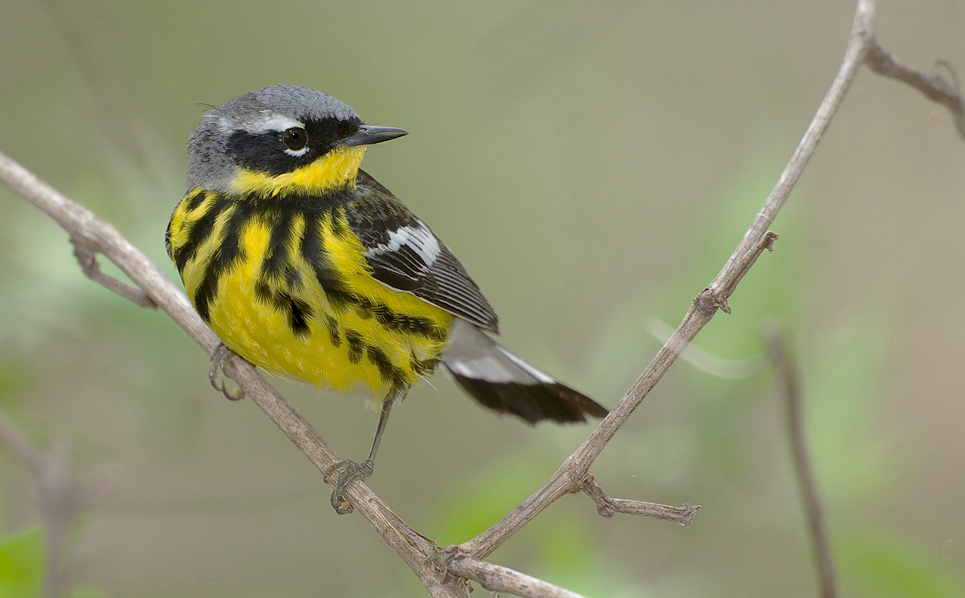 Magnolia
warbler (ďMaggyĒ). These
birds are so pretty I never tire
of shooting them. Itís one of my favorite warblers. In the second week of May they tend to be very common. 1/300sec 400mm f/5.6 ISO400 In the late afternoon the crowds had thinned considerably, due to the cool weather and the wind that had picked up. Around 4 or 5pm something suddenly happened: the floodgates opened, and all of a sudden there were birds everywhere. The wind sarted blowing like hell from the west and the birds all just dropped down to eye level. We had five or more species all right in front of us all at the same time. By this time my entire body hurt with the effort, but we all just kept shooting, despite how tired we were. This was turning out to be one of the best days weíd ever seen at Magee. The intensity of the bird activity was actually mindblowing. After a bit the activity died down somewhat, and we were only getting black-throated greens. Just then my friend Tom got a call from our buddy George, saying that the west entrance was really hopping, so we all rushed down there as fast as we could. Before we even got to the west end, a bit before reaching the West Tower we started to encounter some significant activity again. This time, however, I was stunned to see that a number of the birds were blackburnian warblers, and that they were foraging down at eye level. This is one bird that Iíve been desperate to get some better photos of, and here, finally, was my chance:  Blackburnian
warbler foraging 15 feet away at just over eye
level. This
is one of the best blackburnian photos Iíve gotten yet, and this isnít even my best photo of this bird from this year (see below). This turned out to be a great year for this bird at Magee. Every year is different. Thatís why I go every year. 1/300sec 400mm f/4.0 ISO500 Every time I turned around there was another blackburnian foraging at eye-level just a few feet from my face. I had never seen so many blackburnian warblers together in one place, and so close. Unfortunately, the natural light was terrible, so I had to rely almost entirely on flash. That creates problems for situations like this, because with the use of strong flash thereís a delay between shots as the flash unitís capacitors recharge. If you shoot too quickly in a situation like that you just get a lot of under-exposed images because the flash unit doesnít have time to fully recharge. So I did my best to control my impatience and shoot slow enough to allow the flash to recharge between shots. Meanwhile the birds frantically foraged, oblivious to me and the other birders around me.  Blackburnian
warbler at eye level, so close I could almost
reach out and
After
shooting the blackburnians for a while I
remembered that our goal had been to get to the
west end to meet up with George, who had been
seeing some fairly intense activity near the west
entrance. When the blackburnian activity
suddenly hit a lull I turned and hurried the rest
of the way to the west end. By that time the
bird activity had apparently ceased near the
entrance, but just outside, beyond the platform,
we were confronted with a stunning sight: a
radiantly beautiful scarlet tanager foraging at
eye level at the edge of the woods:touch it. The foliage is denser than Iíd like, but thatís how Magee is. You have to take what you can get. I was still satisfied: I couldnít get photos like this back home. We have plenty of warblers, but they donít get close like this. 1/300sec 400mm f/4.0 ISO400  Tanager
foraging at an insanely close range at the west
entrance. The bird
didnít even seem to notice that it was surrounded by photographers. 1/300sec 400mm f/5.6 ISO800 Apparently the bird had been seen off and on for several days near the west entrance. Some of my friends had taken photos better than this of this bird yesterday or the day before, when the lighting was more dramatic. I was just glad the bird was being so cooperative: it was blatantly ignoring our presence, foraging among saplings at the edge of the woods, only 10 or 12 feet away from where we stood. As the tanager moved about we found another blackburnian and a Cape May warbler in the same clump of trees, all fairly low. In the large tree behind us we also found a female bay-breasted warbler and a black-throated green. My entire body was in pain, but it was easy to ignore the pain in light of the amazing shots I was getting. At some point the light levels dropped below some threshold and the birds suddenly all disappeared. A few rabbits came out to munch on the grass nearby:  Rabbit coming
out to munch on the delicious evening grass.
1/300sec 400mm f/4.0 ISO1250 At this point I had been in the field for 12 hours and desperately needed to rest. Today had been amazing: it was just about the best day Iíve ever had at Magee Marsh, and thatís saying a lot, given some of the amazing days I have had here over the years. In fact, the only day that I can remember that was better was from two years ago when it was raining and the wind was howling out of the north and the warblers were literally walking on the boardwalk just about all day long ó yes, really walking on the boardwalk. But today was a close second after that day. Species seen today included the following: warbling vireo (just 1), many black-and-whites, lots of magnolias, pretty many chestnuts, a blackpoll, ovenbird, tree swallows, sandhill cranes (heard), an immature eagle flyover, common terns, unusually cooperative yellow warblers, extremely cooperative black-throated greens, NO prothonotaries (?!), a pine warbler, a female Cape May, parula at the tower, wilsonís (too far for me to photograph), common yellowthroat, orange-crowned warbler, blackburnian, solitary vireo, male and female redstarts (several, mostly males), ruby-crowned kinglet, gnatcatcher, northern waterthrush, lincolnís sparrow, swainsonís thrush, veery, ovenbird, red-winged blackbird, grackle, white-crowned and white-throated sparrows, robin, catbird, oriole, tanager, and a mourning dove on a nest with large chicks. One thing I noticed today ó the leaves came out pretty agressively this year, which definitely affects the birding:  Middle section
of the boardwalk at Magee, mid-May. Notice
all the leaves! In some
years the leaves would just be starting to come out, but this year things were aggressively leafing out pretty early. This profoundly affects the visibility of the birds. Sunday May 12 - (12 hours, 2020 photos) I woke up this morning realizing that yesterday was one of the best days Iíve ever had at Magee Marsh. Little did I know this morning that today would turn out to be even better. In fact, I think today was the very best day Iíve ever had at Magee. Wow. The girls and I hit McDonalds for our much-needed high-calorie breakfast and then zoomed to Magee as fast as the car would take us. I expected the crowds to have thinned substantially, and indeed they did: the combination of cold weather and it being Motherís Day did wonders. The parking lot was still pretty full, but not insanely so like yesterday. When I arrived I parked next to Tomís truck as usual, but everybody was already on the trail. I took the dogs for a quick swim in the lake, then put them in the car and set up my big 600mm rig. As I was doing that, Dale arrived and said heíd just birded the east beach and it was excellent, with no wind and good numbers of birds. I took the dogs over there and did see a few warblers, but wasnít able to get any good shots. So I again put the dogs in the car and swapped the big tripod-mounted 600mm rig for the much lighter hand-held 400mm rig with extension tube for close focusing and hit the boardwalk (the east entrance). The crowds were much sparser, though there were still quite a number of people. I started out slowly as I always do (morning lethargy, sore limbs). There were some birds here and there at the eastern end of the boardwalk. Nashville warblers were showing themselves a bit. Black-throated greens were in their typical high numbers:  Black-throated
green warbler. These birds are so common in
mid-May that at some
point I just start ignoring them altogether (in order to not miss shots of other birds). Iíve already got millions of photos of this species. But theyíre so pretty that I always convince myself that I need at least one more. 1/300sec 400mm f/5.6 ISO400 On the south edge of the big loop I spent some time stalking Nashville warblers and other things, but it was so twiggy and leaf-ridden I ended up getting frustrated. So far it wasnít turning out to be a great day. Around mid-day things finally started to improve, mostly around the middle and eastern parts of the boardwalk. Someone found a woodcock feeding on the south edge of the big loop, Nashvilles started to get common on the south and east edges of the big loop, and black-and-whites were appearing in some numbers. There were a few straggler palm warblers still around (one of my favorites!), and even some yellow-rumped warblers. Many people were talking about the Audubonís warbler that had been sighted, but I didnít get a chance to see it. Around 4pm I finally found the prothonotary, on the southern edge of the boardwalk, foraging at my feet along the edge of the marsh. I had to get on my belly for this shot, and I literally got stepped on by several impatient birders who were ecstatic to see this amazing denizen of the swamp so extremely close:  Prothonotary warbler, finally showing up. These are without a doubt the most breathtaking birds at Magee. Though theyíre common back home, I happily shoot every single one I see at Magee, because theyíre so beautiful. 1/300sec 400mm f/5.6 ISO500 It only took about 5 minutes for me to realize that this is, without a doubt, the most breathtaking bird at Magee. You can chase all the rare birds at Magee if you want, but Iíll take a prothonotary warbler any day. Iím sure my photos donít do them justice: in real life, they seem to glow with a radiance of their own. In my home state of North Carolina we have many prothonotaries, so I donít need to drive 11 hours to shoot this bird, and yet here I am shooting the same birds that I could easily shoot back home. Why? Because theyíre simply unbelievably beautiful. Iíve yet to meet a prothonotary that I can say ďnoĒ to. In my book they trump everything.  Prothonotary warbler at Magee. This photo doesnít do this bird justice. In person the bird literally seems to glow with a light of its own. I am always in awe when I see this bird. 1/300sec 400mm f/5.6 ISO500 Soon after
this the birds once again just seemed to
explode into view at eye level.
Black-throated green warblers were everywhere.
I was shooting them at eye level at a distance
of literally 4 feet and sometimes even 3 feet,
with some birds coming within 2 feet of my
face (I couldnít focus the camera then).
I shot so many of them that I was forced to
stop shooting that species, to avoid missing
out on the others.
Near the bridge the birds came down so low that many started foraging on the ground, including mutiple red-eyed vireos who had just arrived, and a Louisiana waterthrush that foraged back and forth over and over again on a log (many people enjoyed that scene). At various points the activity became so intense that I quite literally couldnít decide where to point my camera. As soon as I settled on one bird, another would show up even closer or in better light or a better pose. Near the pier that juts out southward into the marsh I simultaneously encountered two birds that I desparately wanted to get good photos of: a Cape May and a bay-breasted. As you can see below, I decided to focus on the Cape May and was justly rewarded:  Cape May warbler close to the pier near the middle of the boardwalk. The activity was so intense at this point that I couldnít decide where to point my camera. 1/300sec 400mm f/5.6 ISO400 Soon after that things just became insane, with Cape Mays and bay-breasteds popping up all around me at eye level. In one tree I had a Cape May, a bay-breasted, and a blackburnian all in the same tree at the same time. A chestnut-sided (whoíve been common yesterday and today) and a magnolia (also semi-common these two days) joined them, and then to top it off an intense yellow warbler with a reddish head popped up at eye level right there. As they say: when it rains it pours. The problem is that itís hard to focus on any one bird when all these super-sexy birds are hopping about. Once the frenzy died down I moved on. I ended up doing the full boardwalk twice, taking a break between tours to let my dogs swim in Lake Erie. The black-and-white below is just one bird I encountered in the late afternoon:  Black-and-white warbler. Once again I depended heavily on flash to illuminate fine details in the plumage of this very contrasty bird. 1/300sec 400mm f/5.6 ISO640 Around 6:30
things picked up considerably, and I was once
again surrounded by a frenzy of birds.
Once again there were so many birds around me
that I couldnít decide which way to point my
camera. There were blackburnians,
bay-breasteds, and warbling vireos, all
favorites of mine. I decided to
concentrate on the blackburnian warblers
(probably because of their intense
coloration), and was pleased to find that I
was able to get even more detailed photos of
them than yesterday:
 Blackburnian warbler. Iíve long wanted to get some close-up, detailed shots of this bird, but never had the chance until now. In past years I just never got lucky with this species. Every year is different. 1/300sec 400mm f/5.6 ISO320 Itía actually a bit surprising that it took me over five years of coming to Magee to finally get these photos. Blackburnians always seemed to show up late during my Magee trips; this year their numbers seem to have balooned a bit earlier, and that may explain my having better luck with them this year. Keep in mind that these photos were culled from thousands taken in the field. If you only see one individual and get to shoot it for 30 seconds, youíre less likely to get killer shots than if you encounter 10 or 20 of them and can spend a solid half hour shooting them in good conditions. This is one of the differences between birdwatching and bird photography: many birders donít realize how difficult bird photography is, and that it can take hundreds or thousands of hours in the field just to get a handful of decent photos of a particular species. It really is that hard. And being a perfectionist doesnít make it any easier.  Blackburnian warbler. Though this bird appears to be patiently posing for my camera, in fact it was frantically foraging, making it very difficult for me to get a tack-sharp image. My strategy is to wait to shoot the bird until it pausesóthat is, until itís perfectly still. 1/300sec 400mm f/5.6 ISO500 Another
thing to keep in mind is that although these
birds appear to be posing very patiently for
my camera, they were in fact almost constantly
in motion, frantically foraging for the
necessary calories they will need to complete
their migration beyond Lake Erie.
Capturing tack-sharp still shots of birds
during such intense activity requires not only
top-notch gear and superb technique, but also
a very considerable amount of luck.
My strategy is to take a shot every time the
bird stops moving, but the problem is that in
the time it takes for me to decide the bird is
being still enough for a shot, for me to
actually press the button, and for the camera
to acquire focus and raise the SLR mirror and
open the shutter, many milliseconds have
passed and in many cases the bird will already
be in motion gobbling up the next
insect. Many times the camera gets a
blurred shot of the bird as it suddenly
springs into motion. To get a tack-sharp
image at flash-enabled shutter speeds of a
mere 1/300 sec requires both fast reflexes and
a substantial amount of luck in capturing the
bird during its brief periods of inactivity.
 Another Blackburnian shot. Iíd really rather that that twig wasnít in the way, but Magee is very twiggy, and you have to take what you can get. I was just happy to be seeing these birds in such large numbers, and so close. 1/300sec 400mm f/5.6 ISO320 The nice
thing about luck is that you can compound your
chances by repeating an attempt many, many
times in hopes that at least one attempt is
successful. Thatís my main strategy with
warblers. I take thousands of shots, and
I expend the utmost effort for every single
one of them, in hopes that one will turn out
OK. In truth, many warblers that I see
donít give me a chance to take enough shots to
ensure that at least one is good, so many
beautiful birds that I encounter at Magee
donít let me get a really good shot of
them. Thatís why itís necessary to spend
at least five days or, preferably, one or two
weeks intensively shooting the birds in hopes
of getting a decent cull of good shots.
Trust me: when you get home and view your
photos in Photoshop, many that you thought
would turn out great end up being a bit too
blurry when viewed at full-size on your
computer.
 Bay-breasted warbler. This is another one of my favorites. I never seem to be able to get photos of this bird that Iím satisfied with. This year there were quite a few of them and I had a little more luck, though thereís still room for improvement in my Bay-breasted portfolio. 1/300sec 400mm f/5.6 ISO640 Eventually I found myself at the west end of the boardwalk, which was fairly dead. Proceeding out onto the lawn at the west end I shot the bay-breasted shown above (another bird that seemed to avoid me in previous years, but seemed to be more common this year). None of my friends were around, and indeed there was almost no-one within sight. It was about 7:45pm. There were some white-crowned sparrows foraging in the lawn at the edge of the forest, where I had actually seen a few yesterday. I donít get to see those much back home (we mostly have white-throated sparrows instead), so I gladly shot a few that were hopping about on the ground about 15 feet away. (The photo below is of this same species that I shot earlier in the day).  White-crowned sparrow. I rarely see these back home, and that strong head patterning always catches my eye when I see them. Though the scene is a little busier than Iíd like, it is a typical habitat for the bird, and at least the bird stands out a bit from the background. 1/300sec 840mm f/7.1 ISO640  Brandy (left) and Daisy (right), swimming at the dog training beach (Lake Erie). 1/500sec 700mm f/5.6 ISO 640, Nikon D300s (Photos by Tom Henneman, used with permission). Ken Kaufman, a well-known birder who manages the refuge, posts his predictions every few days regarding the likely patterns of migration in the days ahead (based primarily on weather predictions), and these are often worth considering, even if they donít always prove 100% correct. His predictions today were that we should see some new birds arriving tomorrow night, resulting in a somewhat different cohort of birds present on Tuesday, but with a bigger arrival after that making Wednesday a potentially more productive day. Monday May 13 - (10 hours, 1564 photos*) This morning when I arrived the crowds were even thinner than yesterday, and the birding, unfortunately, also seemed to be much less productive. One new development was the discovery of a woodcock nest out in the parking lot. Someone had roped it off to protect the birds from accidental trampling; even with the obvious roping it was very difficult to actually find the bird in binoculars or a lens: 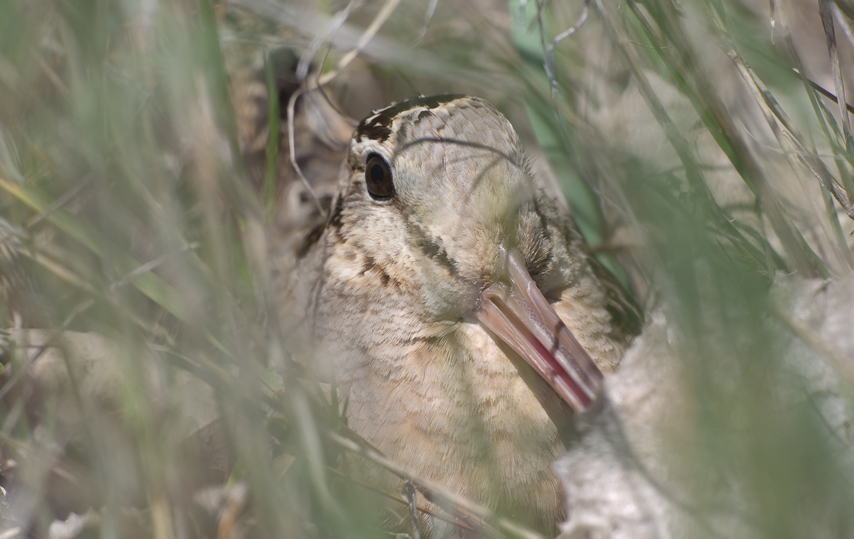 Woodcock sitting on a nest in the parking lot. The bird was so well camouflaged it took me several minutes to find the bird, even after people pointed it out. 1/300sec 400mm f/5.6 ISO100 Many,
many people came by to see this bird; like
many birds at Magee, over the coarse of
several days Iím sure this bird was seen by
many thousands of people. Itís worth
noting that several more woodcocks were
found foraging along the boardwalk this
week.
Given how slow the birding was turning out to be this morning, I decided to take my dogs for a walk. Theyíd spend most of the past three days in the back of the car, so they really needed it. Also, the lighting was too harsh for my liking, making bird photography difficult (I like even lighting so that all parts of the bird are comparably well-lit ó this is true even when using flash). After a nice long walk I put the girls in the car for their nap and then hit the boardwalk. Numbers of birds were way down from yesterday by my reckoning, though what birds remained were at eye level and reasonably close throughout most of the day.  Black-throated blue warbler. These birds are very difficult to expose with flash, because the blue feathers produce glare, changing their apparent hue. 1/300sec 400mm f/5.6 ISO400 The big development today was that a second male prothonotary arrived overnight and now the two males are beginning to squabble over territorial boundaries. The action has mostly been confined to the area between the small loop and the bridge, near the mid-way point on the boarwalk. As I mentioned yesterday, Iím always glad for more opportunities to shoot these birds. No matter how many thousands of photos I get of them, Iím always eager to get more images of these breathtakingly beautiful birds:  Prothonotary warbler ó king of the swamp. 1/300sec 400mm f/5.6 ISO400 One really nice thing about the
prothonotaries at Magee Marsh is that they donít
care how close people get, or how many photos
people take ó even using flash. Iíve
literally seen prothonotary warblers preen for
15 minutes on a limb in front of 30
photographers all banging away with full-flash
photography, the bird entirely oblivous to all
the attention. Strange though it seems,
the birds simply donít care about the attention,
nor about all of the bright flashes from
cameras. Not all warblers are as intrepid
as the prothonotaries when large crowds begin to
form. This particular species seems
notably unperturbed by humans nearby; Iíve seen
this very clearly on their breeding grounds back
home in North Carolina, and even back when I
used to bird-watch extensively along the Potomac
River in Washington, D.C. when I lived in the
nationís capital.
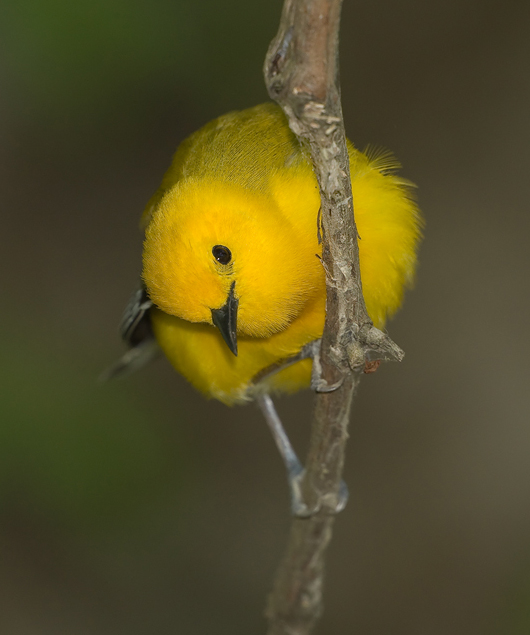 Another prothonotary shot. Not only are these birds breathtaking in appearance, but they also seem to enjoy striking dramatic poses. 1/300sec 400mm f/5.6 ISO400 One
important thing to keep in mind about Magee
Marsh is that there are often extreme
day-to-day differences in the birding
intensity during spring migration. The
warbler activity is highly dependent on the
weather, and particularly on the wind
patterns. Iíve seen this firsthand: a
seemingly subtle change in the winds overnight
can result in an enormous change in birding
quality the next day. Remember that the
birds are only here because theyíre waiting
for a strong tailwind to help them get across
Lake Erie into Canada.
But other conditions also strongly affect birding quality. Rain tends to improve prospects for bird photography because the rain knocks the insects into the lower branches of the trees and the birds follow, making them more accessible. Also, the direction of wind affects where on the boardwalk youíre more likely to have luck seeing the birds: a northerly wind causes the birds to concentrate on the southern edge of the boardwalk (along the edge of the swamp), while a southerly wind pushes them to the forest edge where you can see them from the western lawn or along the closed access road (you can find a map showing these locations at www.MageeMarsh.org, which I help to maintain).  Prothonotary warbler. Not only does this bird seem to love attention, but it seems to have taken lessons from Madonna in striking poses. 1/300sec 400mm f/5.6 ISO500 Today I ran
into Ken Kaufman, who reaffirmed his
predictions that the birds should show up
tomorrow in increased numbers, with an even
bigger explosion the day after tomorrow.
These are only predictions, though, and
prediction is never 100% certain. But
educated guesses like Kenís are always
useful. I highly recommend checking Kenís blog daily when
vising Magee (or when planning a trip to
Magee).
On a more technical note, today I decided to try a new shooting style. I decided to enable the continuous autofocus and high-speed shutter modes on my camera, so as to indulge in the ďspray and prayĒ technique that a number of photographers use. Spray-and-pray is simple: point the camera at the bird and hold down the shutter-release button while the camera rapidly fires off dozens of shots at high speed. Many photographers use spray-and-pray in hopes of increasing the number of sharp images for birds that are in rapid motion, but Iíve always preferred to take a manual approach, in which I try to apprehend the birdís movements and try to press the button at just the right time (when the bird is still, to avoid motion blur). Both methods have their tradeoffs. What I found today is that itís important to help the cameraís autofocus by releasing my finger and re-engaging the autofocus manually whenever possible, to force the camera to re-aquire focus. Otherwise the camera gets lazy sometimes and doesnít change focus when the bird moves a little (resulting in the bird being slightly out-of-focus). Continuous autofocus with high-speed shutter mode can help you get motion shots, but when shooting with flash at 1/300 sec sync speed these still tend overwhelmingly to be blurred. My problem is that I prefer well-lit subjects, and that means using strong flash at slow shutter speeds (no hi-speed sync), so spray-and-pray drains my capacitors too quickly, making it pretty useless. Just for today I reduced my flash power so I could try spray-and-pray again and see if I could make it work. As a result, my count for todayís in-field shots is substantially inflated relative to other days from this yearís trip. The image below was obtained via spray-and-pray. Iíll let you decide whether the result was acceptable:  Prothonotary shot using the spray-and-pray technique, in which the camera uses continuous autofocus and high frame rate to do machine-gun-like shooting. For this technique to work you have to turn down your flash power considerably, or your flash capacitors wonít be able to keep up. 1/300sec 400mm f/5.6 ISO500 Other than
the massive number of photos that
spray-and-pray generates, and how quickly it
fills my cameraís internal image buffer (and
my memory card), I find spray-and-pray to be a
reasonable technique. I probably wonít
switch to spray-and-pray as my main strategy
for shooting warblers, though. Iíve done
fine in the past with my one-shot technique,
and Iím not enthusiastic about having to
process 5x or 10x as many images as I normally
do, which is one of the costs of this
technique.
On a less technological note, today I suddenly remembered how much I love walking the Magee boardwalk, stalking the birds carefully and deliberately for hours on end, even long after my body has started to hurt from the extreme effort. Thereís a certain magic at Magee that always inspires me to push myself harder. At Magee I never know what waits for me around the next corner. I always feel thereís some bird somewhere, maybe just around the next bend, that is waiting for me to immortalize it by capturing a stunning image of it for all the world to see. That motivates me to keep going, even after 12 hours in the field of physically excruciating effort. And itís not about my getting that photo for me: itís about showing the world the bird. Most birds never receive any human attention whatsoever. And Iím sure theyíre perfectly happy with that. The problem is that the aggregate human impact on bird life is enormous, and itís only projected to get worse as human greed for natural resources continues to expand. If our native birds ó particularly our neotropical migrants, including our new-world warblers (such as the lovely prothonotary warbler shown below) ó are to have any chance of avoiding massive declines or even in some cases extinction in the decades ahead, they absolutely will need to get a greater share of our attention and consideration. My job as a photographer is to help them to get that attention: to generate public awareness of these beautiful, precious, under-appreciated co-inhabitors of our small planet.  Prothonoary warbler: currently a very common species. Yet even these could experience declines if human impacts are not mitigated in the years ahead. And many other warblers are not nearly so well-off as the prothonotary. 1/300sec 400mm f/5.6 ISO640 Another thing I learned today: Everyone loves my dogs! Almost every person who walked by when I had my dogs out of the car stopped and asked what breed they were (chocolate labrador) and whether they were sisters (ďThey look like identical twins!Ē). Tuesday May 14 (8 hours, 575 phtotos) When I arrived this morning I found that the numbers of birds were way down from yesterday, and the species were the same ones Iíd been photographing for several days (no new species having arrived overnight). And unfortunately the crowds were fairly thick, making it difficult to work the birds that were present (I need to be able to move around rapidly when working a bird, to get the right angle at precisely the right time). This trip has gone so well this year that Iím pretty sure itíll turn out to be my very best year at Magee Marsh to date. In fact, itís gone so well that Iím already satisfied with the shots Iíve got so far, and think that I might just drive home tomorrow. Vacation days are precious resources, and Iím also concerned about the fact that my poor dogs have spent the last several days confined to the car while Iíve liberally enjoyed myself on the boardwalk for endless hours. Theyíve been patient these long days, and they really deserve a break. Thus I decided that today would be the last day of my trip. The morning was very slow for birding (with harsh sunlight, which is bad for photography), and I feared it might be three or four days before another wave of birds arrived. I decided to give the girls a break from the car and take them for a long walk this morning at Ottowa National Wildlife Refuge, which is located next door to Magee, just to the west. Ottowa is very nice, and there are certainly many birds, but itís much more spread out than Magee, so I donít recommend it for serious warbler photography. It is a very nice place to take a break from Magee. The first thing we found was this great-horned owlís nest:  Great-horned owl at Ottowa NWR. This adult was brooding several chicks (not visible here). This shot was taken at a considerable distance, from the main trail. Soon after I took the shot a busload of schoolchildren came by with a park ranger and scared the bird off. 1/300sec 700mm f/7.1 ISO1000 (hand-held) The adult
(shown above) was brooding two very large
chicks (not visible in this shot). The
nest was apparently well known to many people,
because we were only there for about 10
minutes before a busload of elementary-school
children, led by a park ranger, arrived to see
the birds. At that point the adult flew
off, leaving the chicks unattended.
Back out at the parking area we saw an adult bald eagle suddenly fly by. My camera settings were all set for shooting warblers, so I had to rapidly change all my settings for a dark bird flying in front of a bright background. My first few shots were terrible, but thankfully I was able to get the camera settings right before the bird flew out of range (and keep in mind that these are hand-held shots using a huge, heavy 700mm rig):  Bald eagle at Ottowa NWR. Not a great shot, but Iím glad I was at least able to get a sharp image of the bird, given that all my camera settings were wrong when it flew by. 1/1250sec 700mm f/7.1 ISO250 (hand-held) And that
reminds me that this year there is an eagle
nest located right in the midst of Magee
Marsh, around the mid-point of the
boardwalk. The authorities have roped
off that part of the parking lot to keep cars
from disturbing the nest, but as far as I know
the birds have been spending only very minimal
time there. At this point itís far too
late in the season for them to be laying any
eggs, so theyíll have to wait till next year
anyway.
 Bald eagle nest located right smack in the middle of the Magee boardwalk. Apparently the birds built the nest in winter, before realizing that this would become a high-traffic site for humans in spring. As Benjamin Franklin well knew, bald eagles are skittish birds. I doubt this nest can be viable with all the human traffic on the boardwalk. 1/300sec 400mm f/5.6 ISO250 While
thinking about whether I should leave
tomorrow, I suddenly realized that I hadnít
seen a Kirtlandís warbler this year. For
the past two years Iíve been treated to a
close-up view of an endangered Kirtlandís
warbler at or near the very end of my Magee
visit. My friends and I were just
talking yesterday about whether weíll get to
see one this year. Just about every year
one shows up.
In the afternoon I returned to Magee from Ottowa and was about to take my girls swimming when some birders informed me there was a female Kirtlandís warbler on the East beach (where they usually show up), and that it had been there all day. I headed out there with my big 840mm rig (600mm f/4 lens with 1.4x teleconverter), but the bird wasnít cooperating, and shooting it was very difficult. By this time there were only about 15 or 20 people left watching the bird (the huge crowds from earlier had apparently dissipated). Nevertheless, it was difficult to move around as I followed the bird, due to all the other photographers in the way. Also, the bright sunlight made exposure very difficult.  By the time I found out about the Kirtlandís warbler, the crowd had thinned to about 10 people. Together we ringed the bush where it was hiding, all of us hoping to get a shot. But the bird was very shy and only came out of its bush for a minute at a time. My patience only lasted about an hour. After that I gave up. The bird
stuck to one central bush that it liked, only
occasionally coming out very briefly to a
nearby shrub, or to the ground or to a branch
out in the open. But those forays were
always very brief, and shooting the tiny bird
at that distance, with all manner of twigs and
branches in the way, was just downright
frustrating. Early on I gave up any hope
of getting decent images of this bird.
The bright sunlight made all my exposures very
contrasty, and most of the promising angles
involved shooting into the sun.
 The bush in the very center of this photo is the one where the Kirtlandís warbler persisted in hiding. Occasionally it came out to a low branch on the very periphery of the central bush, and then shot back into the protective confines of the bush. The direct sunlight compromised even those photos via strong constrast patterns, wreaking havoc on our exposures. Itís a miracle I got any usable photos at all. And yet... On top of
everything else, I realized I was using my
other camera body which had all the settings
wrong. I stood there in the 80-degree
afternoon hoping against hope that Iíd be able
to get at least one half-decent image of this
bird. Itís always difficult to judge
from the tiny preview images I see on my LCD
whether Iíve got a decent photo of the
bird. Mostly I just rely on taking as
many photos as humanly possible, and then
hoping that some tiny minority end up, by
sheer luck, looking great.
It looks like luck was on my side this year, after all: at least I was able to get a tack-sharp image of the bird, despite all the difficulties:  Kirtlandís warbler on the east beach. Despite the ridiculously difficult shooting conditions this year, I was able to get images better than those of last yearís Kirtlandís (though still not quite as good as those from two years ago ó primarly due to the backgrounds). Keep in mind that this is an endangered species that technically is out of its normal range ó so we always feel fortunate to see it here at Magee. Iím always thankful to even see one of these birds. 1/300sec 840mm f/9.0 ISO200 Last year I
was also treated to close-up views of a
Kirtlands (on the new West End trail), but it
was two years ago that one showed up out here
on the East beach where I got the most
magnificent Kirtlandís warbler photos Iíve
ever seen. And while I was taking those
I had no idea how well they would turn out.
Last yearís Kirtlandís photos were reasonably sharp and well-exposed, but the backgrounds were just disappointing. This year the backgrounds were again a little more distracting than Iíd normally like, but at least I got a handful of images of this endangered bird that were tack-sharp and highly detailed, as well as perfectly exposed:  Another decent shot of the Kirtlandís. At this distance and with this much foliage in the way, I honestly donít know how these turned out to be so detailed. The only thing Iíd like to improve is the background; that could be fixed in Photoshop. 1/300sec 840mm f/9.0 ISO200 I always
have to remind myself to be thankful to even
be able to see this bird. The Kirtlandís
was once in great danger of becoming extinct,
with only a handful of individuals left in the
wild (much like the California condor), but
the fortuitous reversal of its decline has led
to an increase not only in its breeding
population in neighboring states but an
increase in incidental sightings here at
Magee. As you look at these photos, keep
in mind that if things had gone differently
over the past decade, this bird might be
extinct by now. The same is true for
many of our migrant birds. What we do
makes a difference. The human impact on
this planet is now so large that entire
species thrive or go extinct as a direct
result of our activities. The sad truth
is that most people really donít care.
 Another image of the Kirtlandís. This high level of photographic detail was possible only through the use of strong directional lighting (flash). Fortunately, these birds donít seem to mind flash in the least. 1/300sec 840mm f/9.0 ISO200 Late in the
day I ran into my good friend George, and he
and I decided to do the boardwalk together, to
see if there was anything worth
shooting. Part-way through we ran into
our good friend Darin, who showed us a
woodcock actively foraging in exactly the same
place Iíd seen one foraging the other
day. The three of us continued along the
boardwalk, going about 2/3 of the way before
running into what I suspect was the ďmourning
crowdĒ (a
persistent crowd that forms at the usual
location where a Mourning Warbler is typically
sighted). We turned back there and tried
to find something novel to shoot, but the only
birds we found were redstarts (which are
always tough for me to properly expose),
magnolias (which I have lots of photos of
already, though I still love shooting them), a
chestnut (which I always love to see, and
shoot whenever I can), and unfortunately no
prothonotaries. Though a Wilsonís had
been reported yesterday I didnít get one of
those on this trip. The Parulas and
Canadas should come through at some point, but
I canít justify the continued expense of
living on the road (hotels and chinese food
every night cost money...), so in the morning
Iíll leave for the long drive back to North
Carolina.
I decided to end the day by letting my girls have an extended swim in Lake Erie. Though Brandy got to swim here last year, this is Daisyís first trip (sheís an 8-month puppy), and this is by far the biggest lake sheís ever seen.  Brandy (left) and Daisy (right) enjoying the Dog Training Grounds at Magee. This was Daisyís first swim in a great lake (sheís only 8 months old), so this trip was special for her in that regard. Tomorrow weíll drive home and then spend a couple days kayaking on the lake near my home. Though warbler-watching is exciting for us humans, my dogs would much rather spend the day swimming and retrieving sticks. Today was what I would definitely call a ďbad dayĒ at Magee, and even so, I still got a handful of decent photos (not to mention the thrill of seeing and photographing the Kirtlandís!). For planning your own trip to Magee, just keep in mind that youíre likely to have some bad days during your trip, but if you plan your trip around the week of May 15th youíll maximize your chances of being there on a good day. On the bad days, just try to make the most of it, by honing your skills shooting the birds that are there, talking to the other photographers about their strategies and techniques, and getting yourself ready for a good day, whenever it happens. And if you are there on a good day, thank your lucky stars: with the proper equipment and skills you should be able to get some of the best warbler photos ever seen! Wednesday May 15 - DRIVE BACK HOME In conclusion, I can definitively say that this was one of the very best years I have ever had at Magee, even though I only spent four days here this time (also making it my shortest stay at Magee so far). I shot more birds, got more keepers, and had more fun doing it than in any other year, I think (though I still have very fond memories of the day in 2011 when it was rainy and the wind was howling out of the north and we were all freezing cold, but the birds were literally walking on the boardwalk and we were shooting them at point-blank range on the western edge of the big loop, just having a whale of a time...). For me, Magee is partly about getting great photos, but also about spending time in the intimate company of birds, and also, in no small measure, about spending time with my fellow photographers and birders, sharing our recent birding stories, our birding dreams for the future, and enjoying the camaraderie and excitement of being at one of the foremost North American birding sites, at the peak of the migration, collecting images that for each of us will serve as icons of our personal birding memories. As Iíve said many times before: thereís no place Iíd rather be than birding the boardwalk at Magee in mid-May. For me, this is the happiest place in the world. |
*** click thumbnails to zoom ***








